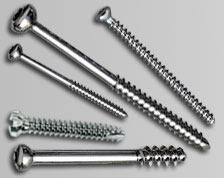- Universal testing machine
- Fixtures
- Medical/Biomedical device
- Vehicles motorcycle
- Compression/Flexural test
- Hardness tester
- Impact testing machine
- Torsion testing machine
- Abrasion & wear tester
- Plastic & Pipe testing
- Tensiometer / Goniometer
- Erichsen cupping tester
- Other Testing Equipment
- Grinding & polishing machine
- Spring testing machine
- Introduction
- Specification
- Accessories
- Standard
- LEAFLET & VIDEO
- Contact Us
Bone screws are the most common internal fixation device and used more then any other type of implant. Bone screws have various applications including driving various designs and sizes of screws. Manufacturers are required to perform device testing in accordance with ASTM F543 and ISO 6475 to determine the mechanical properties of the screw. The ASTM F543 test procedure outlines 4 tests that helps determine different characteristics of the metallic bone screw. Including the TORSIONAL PROPERTIES (A1), the insertion/removal torque (A2), the pullout strength (A3), and the axial compression load force of self-tapping bone screws (A4).

There are four primary testing methods outlined in the ASTM F543 testing standard, as follows:
A1(TORSIONAL PROPERTIES) – This test method is designed to find the breaking angle, maximum torque, and torsional yield strength of the Metallic Medical Bone Screw. The screw will be secured using a collet, and then a drill will be used to drive the specimen screw at the rate outlined in the ASTM F543 medical bone screw testing standard. The results of the test will be measured and cataloged.
A2( DRIVING TORQUE OF MEDICAL BONE SCREWS) – The A2 test is used to measure the insertion depth, insertion troque, axial load, and removal torque of a Metallic Medical Bone Screw. A test block is placed in a specialized clamping device, and a bone screw is lowered by a spindle into a pilot hole on the test block. Then, the bone screw is driven into the test block using torsional force. The maximum torque during these revolutions will be recorded. Next, the process is reversed. After this, the screw will be rotated in the opposite direction to remove it, and the maximum torque during these revolutions will be recorded.
A3 (AXIAL PULLOUT STRENGTH ) – This test is used to determine insertion depth and axial pullout strength. The bone screw is inserted into a test block that is secured into a frame as outlined in ASTM F543 standards. The head of the screw is gripped and subjected to a tensile load of 5 mm per minute. This will only stop once the screw is pulled out of the block or fails completely.
A4 (SELF-TAPPING PERFORMANCE) – This test provides information about axial load, maximum self-tap force, axial displacement, and maximum torque. A test block is clamped in place, and the Metallic Medical Bone Screw is lowered into a pilot hole on the test block and driven at a specified rotational rate. The compression force of the spindle driving the screw will continue to grow until the self-tapping feature of the screw engages and it begins driving into the test block. This load will then be maintained, and the screw will continue to be driven into the test block until a specified number of complete rotations has been achieved.
As experts in ASTM F543 testing, Empirical Technologies Corp simplifies the process of testing for Metallic Medical Bone Screws. At our testing facility, we can perform medical bone screw testing quickly and efficiently, which helps you bring your new products to market with fewer delays.
Torque measuring range | 0-5N.m (10N.m optional) |
Resolution | 0.001N.m |
Torque sensor accuracy | Less than 0.5%F.S. |
Speed accuracy | ±0.01mm/min |
Axial force load cell | 200N/1000N (fulfill axial pull-out test) |
Load cell accuracy | Less than 0.5%F.S. |
Load cell resolution | 0.001N |
Linear displacement sensor range | More than 50m |
Displacement sensor accuracy level | Less than 0.5%F.S. |
Displacement sensor resolution | 0.01mm |
Torsion angle sensor | 99999 degrees |
Torsional angle accuracy | ±0.2 degree |
Torsion speed | 1r/min to 30r/min free adjusting |
Effective travel | 400±10mm (can be increased on demand) |
The coaxiality of the two chucks | ≤ 0.2mm |
Standard Power | 220V, 50HZ, 1 phase, 0.4Kw |
Working system | MS Win10 |
High Stiffness Frame | 1 set | |
Servo motor/driver (Japan Panasonic) | 2 sets | |
Torsion/tensile sensor (5Nm/200N) | 1 set | |
Loadcel 1000N: (USA Vishay Celtron) | 1 set | |
LVDT (Japan Tamagawa liner displacement sensor) | 1 set | |
Test fixture (sample clamping fixture; V chuck; flat chuck) can left/right adjust position | 1 set | |
Torsion test fixture | 1 set | |
Data collection system | 2 sets | |
Professional torsion testing software | 1 set | |
Computer | 1 set | |
Printer | 1 set | |
Documents (Manual, packing list, certificate) | ||
ISO 6475:1989
Implants for surgery — Metal bone screws with asymmetrical thread and spherical under-surface — Mechanical requirements and test methods
ISO 5835:1991
Implants for surgery — Metal bone screws with hexagonal drive connection, spherical under-surface of head, asymmetrical thread — Dimensions
ISO 9268
Implants for surgery -- Metal bone screws with conical under-surface of head -- Dimensions
ASTM F543
Test Methods for Metallic Medical Bone Screws
ASTM F116
Standard Specification for Medical Screwdriver Bits
YY 0605.12-2016, YY 0605.9-2015, YY/T0605.5, YY/T0605.6, YY/T0605.7, YY 0605.12-2016, YY 0605.9-2015, YY/T0605.5, YY/T0605.6, YY/T0605.7, GB/T13810-2017, GB/T19701.2-2016, GB 4234.1-2017, ISO 5832, ISO 9268, ISO 5833, ISO 6475, ASTM F2502, ASTM F543, ASTM F116,










